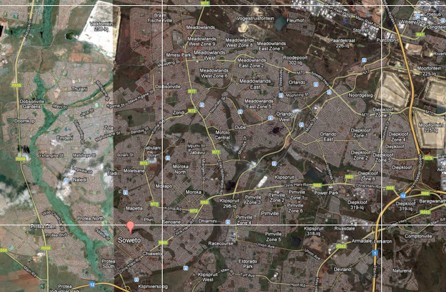
By Toby Simpson
Soweto is located in south west periphery of Johannesburg, Gauteng, South Africa and is comprised of some 32 different townships (City of Joburg, 2008). These townships were created by the Urban Area Act of 1923, allowing apartheid cities to be formed ‘ separate towns for black and white populations, preventing the interracial sale of lands within the population (Parnell, 1988). Two structural constraints confront Soweto: The growth and sprawl of a community that was denied basic rights, and were considered temporary settlements.
In 2007, Soweto covered about 150 square kilometers with a population of 1.3 million residences. Home to approximately 43% of Johannesburg’s residences there are roughly 2000 people per square kilometer (City of Joburg, 2008). With half of Johannesburg’s population Soweto contributes 4% of the economic output. The unemployment rate is 53% (City of Joburg, 2008). Soweto has a mix of income groups with a few million dollar homes while most remain in poverty. Until recent economic development plans the main economic activity of the city focused on the community services sector and due to the high unemployment rates the informal sector.
Due to the apartheid era and through its many transitions Soweto has remained disconnected from the other districts. This has lead to the lack of basic services and transportation. Since the end of apartheid the Reconstruction and Development Programme was established to provide a policy framework for socio-economic progress. The core elements are the development of democratic institutions, equal representation and participation, an integrated society, with sustainable growth and development (MOP, 1994). However, this response is inadequate to address the needs of the poor (Webb, 2010). In 2010, South Africa hosted the FIFA Word Cup, which spurred investment in infrastructure and stadiums.
Future economic development plans must incorporate integrated growth that allows for two key outcomes: mixed-use development and community connectivity for the poorest communities. The development goal is to integrate the physical and social barriers of the past and build on previous investments in infrastructure. The mixed-use development will break the boundaries between the rich and the poor as well as make progress on the goals set in the Reconstruction and Development Programme. The creation of local jobs where workers can take local transport and spend their earnings locally may help to build the sense of community that has yet to be invoked across all classes of society (Ministry for the Environment, 2012). Specific attention must be given to providing adequate basic services and construction projects that allow for all in the community to have access to affordable energy and clean water. Without utilizing both public and private investment into the energy and water the realizations of any economic development plan will not be recognized.
This article is a product of Professor Shagun Mehrotra’s Global Urban Environmental Policy class. Views expressed are entirely those of the individual author.
References
City of Joburg. (2008). The Five Year Soweto Economic Development Plan 2008-2013. Towards building a productive and competitve regional economy. Retrieved on February 4th , 2012, from http://www.joburg-archive.co.za/2009 /pdfs/economic_development/regd_plan.pdf
Google. (2012). Google Earth (Version 6.0.3.2197) [Software]. Available from http://www.earth.google.com
Parnell, S. (1988). Land Acquisition and the Changing Residential Face of Johannesburg, 1930-1955. Area. Volume 20, No. 4, pp.307 — 314.
Ministry in the Office of the President, (MOP). (1994). White paper on the parliament of the republic of south africa on reconstruction and development. Notice no. 1954 of 1994. Retrived on February 3rd, 2012, from http://www.info.gov.za/view/DownloadFileAction?id=70427
Webb, C. (2010). Selling South Africa: Poverty, Politics and the 2010 FIFA World Cup. Global Research, Centre for Research on Globalization. Retrieved on February 5th, 2012, from http://www.globalresearch.ca/PrintArticle.php? articleId=18303
Ministry for the Environment, (2012). The value of mixed use ‘Summary of the value of urban design. Retrieved on February 6th, 2012, from http://www.mfe.govt. nz/publications/urban/value-urban-design-summary jun05/html/page7.html